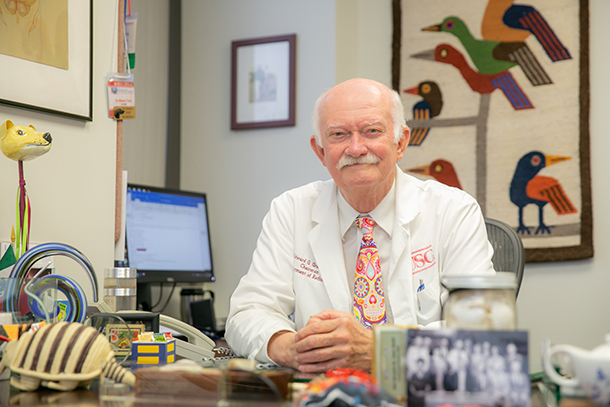Edward Grant, MD, already had a distinguished career by the time he came to the Keck School of Medicine of USC in 2002 as chair of the Department of Radiology. He had made his mark as chair of the imaging department for the VA Greater Los Angeles Healthcare System, and previously had served as vice chair and professor of radiological services at the David Geffen School of Medicine at the University of California, Los Angeles.
Today, as he prepares to begin a phased retirement, his passion for his specialty has not dimmed and he is eager for more bright young medical minds to enter the discipline that has consumed him for most of his professional life.
“Go into radiology,” he offers when asked for advice for young medical students. “It’s just a wonderful field.”
So why, then, is he retiring?
“Because I’m old,” he began jokingly. “Really, the day-in, day-out business of being a chair doesn’t leave time for concentrating on research. I’m ready to pass the torch of that part of my job on to someone else.”
This is where the “phased” part of the retirement comes into play: After leaving the role of chair behind, Grant will still have his hands in the work he loves so much — actively working part-time in the clinical arena and in research, where he began.
After receiving his MD degree at Temple University’s Lewis Katz School of Medicine in his native Pennsylvania, Grant’s academic and clinical career began at Georgetown University School of Medicine, where he was an assistant professor and chief of diagnostic ultrasound. He is recognized as an expert in ultrasound imaging, which figures into many of the 168 peer reviewed articles, 40 chapters and five books he has logged over his career.
Grant’s time in Los Angeles began in 1987 at UCLA, where he served as professor of radiology, chief of diagnostic ultrasound as well as vice chair of the department of radiological services and assistant dean of the medical school.
In 1992, Grant assumed the role of chair of the imaging department at the VA Greater Los Angeles Healthcare System, improving the quality of clinical services and overseeing the development of a substantial program. During this time, he was instrumental in securing millions of dollars in grants and served as the director for all VA radiology programs nationwide. He was at the forefront of adopting Picture Archiving and Communication Systems, or PACS, as well as voice recognition dictation systems which have become the standard for imaging in medicine today.
Upon becoming chair of the Department of Radiology at the Keck School, Grant has overseen its exponential growth, with an increase in robust research projects, a doubling of faculty members and an expansion of high-quality, high-complexity imaging services across the clinical facilities.
Today’s technology has allowed ultrasound imaging to evolve and begin to include more emphasis on contrast enhanced ultrasound (CEUS), which has been a major focus of Grant’s work and research. He said he is glad to see that, “after 25 years of being available in other countries,” his work has allowed the CEUS process to be accepted into the larger world of clinical radiology and research.
Grant’s influence and impact on the world of radiology is felt far beyond the institutions where he has worked. In 2007 and 2013, Grant participated in the Radiological Society of North America’s International Visiting Professor Program, traveling to Mexico to share his expertise with medical schools there. In 2017, Grant’s efforts to advance ultrasound education around the world were recognized when he received the 2017 GE Barry Goldberg Educational Excellence Award from the Society of Radiologists in Ultrasound. He will be honored with the Larry Mack Lifetime Achievement Award in October by the same society.
While Grant’s legacy is already substantial, he plans to continue his work on the effect of CEUS on lowering the cost of imaging, imaging of thyroid nodules as well as a look into liver fibrosis and the non-invasive diagnosis of vascular disease using Doppler ultrasound.


